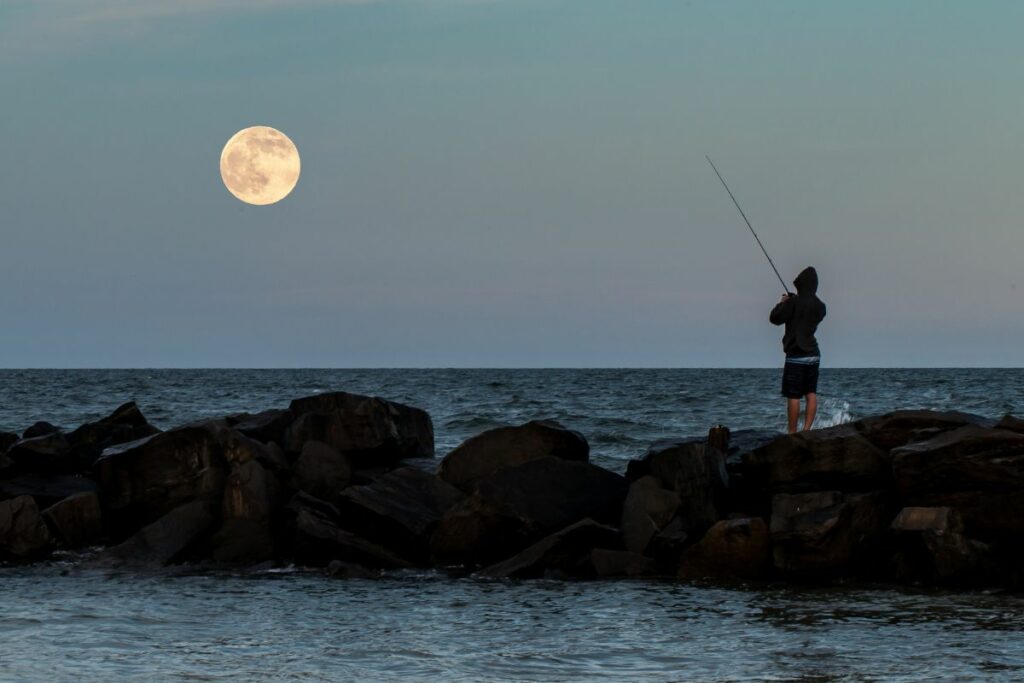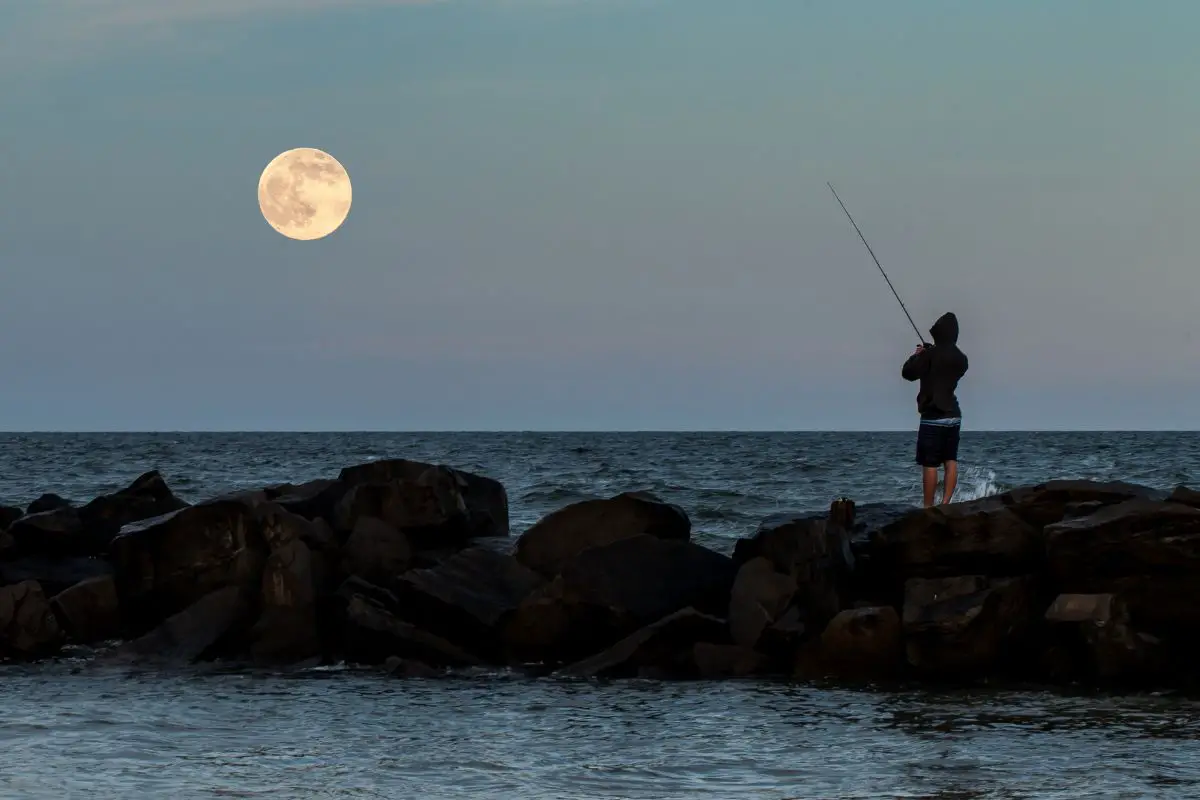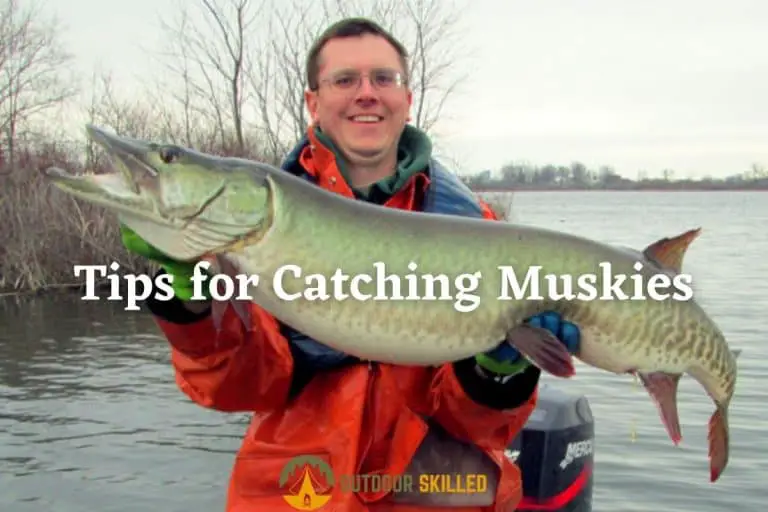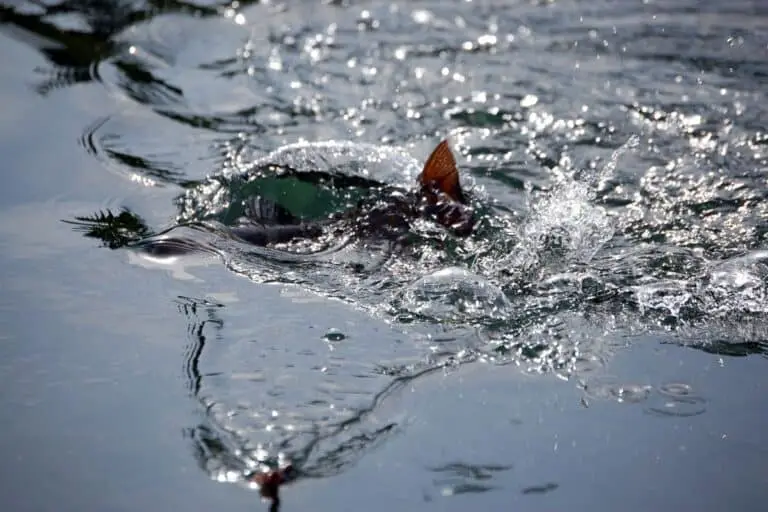What Is the Best Moon Phase for Saltwater Fishing? [Explained Simply]
Learning how to fish can be very exciting. However, many factors can affect your fishing experience, and one of them is fishing in different moon phases. There comes a point when you fish at night, and you might wonder if any of the moon phases affect your fishing.
What is the best moon phase for saltwater fishing? The best moon phase for saltwater fishing is around the time of a new moon or a full moon. Around those times, the gravitational pull will be stronger than usual, causing the tides also to become stronger, which usually makes fish more active. The moonlight will also be brighter, increasing your visibility.
It might be a surprise to some anglers, but moon phases actually play a huge role in fishing. Knowing when to fish depending on the moon phase can make or break your trip. We will discuss how moon phases affect fishing, so keep reading to find out when is the best time to go fishing…
Table of Contents
How Do Moon Phases Affect Saltwater Fishing?

It is believed by many fishermen that different moon phases have different effects on fishing. The reason for that is that the moon directly affects tides. Tides, whether strong or weak, can heavily affect how fish behave and feed.
Tides usually create a lot of friction among fish, which causes them to react differently under these circumstances. For example, full and new moon phases have the biggest effect on saltwater currents. However, currents aren’t as strong during other phases of the moon.
This means that the harder the gravitational pull is, the more friction in the water there is. These cause the most tides and currents, which makes most types of fish react more aggressively and feed more actively. Each moon phase is different when it comes to how fish behave, though.
It’s also said that moonlight affects fish’s feeding habits. During a full or a new moon, for example, there is more light that is being direct at the water. This makes it easier for fish to see and, in turn, feed. This is especially true for saltwater since tides become stronger. Having stronger tides means more active fish.
A full or new moon also affects other prey in the water. When prey and predator activities are higher, it naturally makes fish more hungry as well. A lot of movement causes more exhaustion, thus, making these two phases the ideal times for anglers to fish.
Fishing Moon Phase Theories Explained
There are moon phase theories that anglers believe in when it comes to fishing. There is not much scientific evidence of them, however, anglers have witnessed changes in saltwater fish behavior based on their experience.
The energy effect theory
Some of these theories state that when gravitational pulls are strong, they force more energy into the water and then make saltwater a harder environment for the fish to live in. This makes fish exert more effort to search for food.
The aggressive feeding theory
It is also speculated among fishers that when the sun and the moon are on opposite sides of the earth, the gravitational pull increases, which causes ocean tides. Ocean tides cause friction among fish, which makes them more aggressive when feeding.
The predator Theory
Another theory many fishermen believe is that the best time for fishing is a few days before or after a full or new moon, and not the exact day. That is because it is said that predator fish take the opportunity during that time to feed more on the surface of saltwater.
This theory states that each of the moon phases affects tides and currents differently in saltwater which has a huge effect on the fish. Anglers advise you to pay attention to when the moon is rising and when it is setting. Fish might also react differently depending on the location of the moon.
It is important to look at a monthly solunar calendar and plan your fishing trips around those. Knowing which feeding times are best for the fish you’re trying to catch is also just as important. The moon phase theories have been known to help many anglers catch the biggest of fish.
The Solunar Fishing Calendar
The solunar calendar predicts the exact time when fish will feed. These calendars predict four different periods of fish feeding. Two of them are major, and the other two are minor. They indicate the best feeding times over a 24-hour cycle.
To explain further, a major period lasts between 60 and 90 minutes, and it usually occurs when the moon is overhead, and it occurs again when it’s in the opposite direction. A minor, however, usually lasts for 35 to 45 minutes, but it occurs between the two major periods.
Fish tend to feed very aggressively during these times. The solunar calendar shows when each period will occur. Anglers are very divided on this matter. However, it is known that anglers who do follow the solunar calendar tend to catch more fish.
Using solunar calendars also successfully predicts when tides occur. They show that during major periods the water rises, but during minor periods the tide levels go down. Other factors can come into play, such as strong fronts or excessive rain.
Some anglers have proven that using the solunar calendar works, noting their success after following it. It’s fair to say that it is quite accurate. It’s advised to check these calendars before a fishing trip. Each day requires a different table from the previous.
Here are the Fishing Calendars for the rest of this year, according to the Bass Forecast app
September 2022:

October 2022

November 2022

December 2022

Is A Full Moon Good or Bad for Fishing?

There have been many debates among anglers about whether fishing under a full moon is good or bad. Many have caught some of the biggest fish under a full moon, and some say they haven’t had as much luck. Let’s talk about whether it’s good or bad to fish under a full moon.
Scientists have stated that fishing right before and right after a full moon is the best time to fish, not on the actual night of the full moon. It depends on the type of fish you’re going for. According to some, however, fishing on a full moon night doesn’t bring much luck.
As discussed before, moonlight has an effect on how fish behave. During a full moon, tides start getting stronger, and fish behave more aggressively as a result. This could lead them to feed more actively but could make your fishing experience a lot harder due to the fluctuation in the water.
Since the moon provides the right amount of light for fish to be able to see, it’s easier for them to spot their prey. Bigger types of fish respond better to moonlight than others. So, if you’re not aiming for a bigger type of fish, you can rest assured that you will catch one eventually during a full moon.
With that being said, it’s definitely possible to any type of fish, regardless of size during a full moon. It’s possible to find more stable waters near the mouths of rivers while choosing the right position whether it be upstream or downstream, depending on the type of fish you’re trying to catch.
Which Fish to Target on Full Moon Nights?
Whether you’re a beginner angler or an experienced one, it’s always a good time to learn more about fishing. Learning about moon phases can be interesting and intricate at the same time. Many types of fish bite all year long, but some do prefer to bite under a full moon.
One of the easiest fish to catch under a full moon is bass. Some professional anglers will advise you to go to a lake a few days before the full moon to catch bass. You can check out this guide on how to catch bass at night for more information.
Other popular types of fish include bluegills and shellcrackers. These types usually spawn on new and full moons around March through August.
If you happen to find yourself fishing under a bridge or a dock you will more than likely find species such as trout, jack, snook, and tarpon. The slightly dimmed lights under the bridge from a full moon are perfect for those species. The light isn’t too overwhelming for the fish, and they feel safe enough to bite under these dimmed light conditions.
Bonefish and redfish, on the other hand, feed most when tides are heavy. If you’re planning on going fishing on the exact day of a full moon, you can almost guarantee that you will catch either type of fish. They are usually found in saltwater bodies of water.
Wahoos are another excellent fish to target during a full moon. These types of fish are usually more active at night. It isn’t clear exactly where Wahoos usually swim, but the best time to find time is between July and October because it doesn’t often rain much during those times.
An interesting observation that some scientists looked into had to do with oysters. Biologist Dr. Frank A. Brown concluded that oysters usually open their shells up during a full moon due to the high tides. They then returned to their normal habits when the moon was overhead or below.
There are some species of fish that you should avoid during a full moon phase due to their lack of correspondence under these conditions. The tides might get a little too frightening for these types of fish. These types include king mackerel, sailfish, and Mahi.
Tips for Full Moon Fishing
Here are some tips that you will find helpful when going full moon fishing.
- It’s important to know where exactly to go for full moon fishing.
- Since a full moon is known to bring major tides, anglers should expect to catch big fish. Bigger fish tend to react the most to tides.
- You will want to go inshore to catch these bigger swimmers because they usually tend to look for prey around those areas.
- Bigger fish are usually uninterested in looking for food offshore during a full moon.
- Using the right bait is also highly important when it comes to fishing under a full moon.
- For example, if you’re used to using baitfish, you will notice that they also react differently under a full moon and in saltwater.
- You have to also know that although there aren’t really any tides in freshwater areas, a full moon has an effect on freshwater fish as well.
- Largemouth bass fish are tremendously active during a full moon, and they usually seek prey near surfaces of freshwater that are looking to feed on the same sources.
- It’s advised to follow a lunar calendar when going fishing.
- As discussed earlier, major and minor periods bring out different outcomes on how different fish behave.
- For example, larger types of fish usually tend to feed more actively one or two hours after a major period. They also feed during a minor period.
- Another good tip is knowing how the moon affects different types of fish.
- Most types of fish will usually rise to the surface during a full moon. The bright light is what attracts them the most. Different types of fish prefer more dimmed phases of the moon as opposed to others.
- It’s good to research the type of fish you’re trying to catch during each phase of the moon.
- Although it’s not completely clear why fish tend to behave differently during a full moon, one thing’s for sure is that a full moon affects tides, which affects how they behave.
- Lastly, having the right type of gear is vital. Check out our guide for the best rods for saltwater fishing as well as the best reels.
- Since fishing in the dark can get difficult, bringing a headlamp could be useful.
- Make sure you’re careful using it, though. Sometimes too much light can scare fish away.
- You want to be as comfortable as possible.
- So, bringing the right type of hoodie suitable for fishing is a plus, as well as bringing the right type of fishing boots. You can find my picks for Fishermen’s wear here.
- You usually wouldn’t need a different type of hook as long as it’s a good size for your bait.
- Keep in mind that fishing during a full or new moon could be dangerous, though.
- Since tides can reach as high as 50 feet above the ground.
- It’s important to put your health and safety first. Many other factors affect fishing, not just a full moon.
- Weather can play a huge role as well.
If water temperatures are too cold for the fish, they probably won’t bite and will seek shelter in deep waters. This is why checking the weather before you plan your fishing trip as well as the solunar calendar is important for your personal safety.
Related Question
Is A Waxing Crescent Moon Good or Bad for Fishing?
A waxing crescent moon is good for fishing. If you want to have success when fishing during a crescent moon, the best times to go would be right after dark and right before dawn. A crescent moon brings on a mixture of high and low tides, which provides anglers with a good opportunity to catch fish.
What Is the Best Moon Phase for Bass Fishing?
The best moon phase for bass fishing is three days before a full moon and three days after. Bass usually bite more aggressively during those times due to the tides caused by a full moon. It’s not the best option to go on the actual day of a full moon, however.
What Moon Phase Is Best for Beach Fishing?
The best moon phase for beach fishing is right before or after a full moon. A full moon provides the highest tidal occurrences. This causes water movements to fluctuate, thus causing many types of fish to bite more eagerly, especially bigger types of fish.
Do Moon Phases Affect Freshwater Fish Behavior?
Moon phases do not affect freshwater fish. Not in the sense of tides, anyway. In the ocean, tides rise 50 feet above the earth’s surface at times, however, in lakes and other fresh bodies of water, the water doesn’t rise more than two inches which causes almost no effect on freshwater fish.
Helpful Resources
Reliable Rods You Will Love (and Can Afford)
- Fishing for Bass? Check out these very sturdy Bass Fishing Rods
- Ice Fishing? These Ice Fishing Rods Will Never Let your down
- Get the best Trout Fishing Rods here, and the best Catfish rods here
- No rods give you a better value for your money than these Saltwater fishing rods
- Get the best Telescoping fishing rods here, the best Baitcasting rods here, and check out these superb Kayak fishing rods here.
- Fishing the Flow: Expert Picks for the 15 Best River Fishing Rods
If you like this article, please share it or pin it, you can find the share buttons below. We will really appreciate it ❤️







